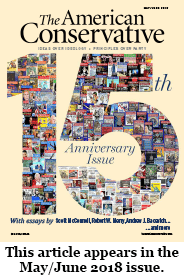
Historians and pundits often compare historical trends to graph lines on a chart, with political moods rising and falling like the heart rate of a cardiac patient. Alternatively, there’s the proverbial pendulum, swinging from left to right, right to left. A better metaphor would be the wheel, circular in shape and motion. They can move in any direction and at any number of speeds. Sometimes they roll forward, sometimes backward, sticking to a narrow groove. Sometimes they keep rolling in one direction, gaining mass and momentum like a snowball and, in the end, often melting like one.
This is what I have witnessed over a lifetime of writing about—and sometimes, as an aide to presidents Nixon, Ford, and Reagan, engaged in making—political history. While my first conscious political recollection is of Harry Truman’s 1948 upset victory over Thomas E. Dewey (I was in kindergarten), I don’t need to go back that far to make my point. A quick glance at what has been going on over the 15 years since the launching of The American Conservative, viewed in five-year intervals, tells the story.

2003: This was the year that many political observers of both right and left thought the Republicans were on the threshold of long-term political dominance. “W”’s performance as mourner-in-chief and then avenging angel after 9/11 had seen the GOP through the 2002 midterm elections and headed for a strong presidential re-election victory in 2004. Karl Rove, a political strategist with considerable historical insight, believed we were in for a long run of Republican executive and legislative dominance similar to the one ushered in by William McKinley in 1896 and lasting all the way to Herbert Hoover. Karl had the maps and charts to prove it, featuring the rise of a moderately conservative exurbanite (far suburb) population bloc, complete with soccer moms. Sure enough, the 2004 landslide came, rolling over the Democrats like a giant snowball…only to melt away in time for the 2006 midterms and the 2008 presidential election. There was nothing wrong with Karl’s analysis, as far as it went. But it couldn’t foresee the costly after-effects of the neocon foray into Iraq or the nasty hurricane that slammed into New Orleans.
2008: And thus TAC turned five with the rise of Barack Obama, who not only trounced John McCain in the presidential election but also ushered in Democratic majorities in both the House and Senate. Now Democrats were talking about a permanent new ruling coalition of young/black/Latino/union member/environmentalist/LGBT voters that would lead us to ever-greener more progressive pastures, starting with comprehensive, compulsory government healthcare. Up to a point, they were right. In his first two years as president, Obama put in a languid personal performance while Nancy Pelosi and Chuck Schumer rammed through what came to be called Obamacare. That was about it, and even that victory contained the seeds of defeat, first felt in the 2010 midterms when the GOP roared back legislatively.
2013: When TAC turned 10, Donald Trump was still a political cloud no larger than a man’s fist—and a rather tiny fist at that. But the GOP, including a number of reforming, conservative governors, seemed once again to have carved out a “permanent” position as the dominant party in a majority of states and congressional districts. It was generally agreed that, as long as the Republicans didn’t engage in fratricidal strife, they were well-positioned to recapture the White House in 2016.
2018: The American Conservative is now 15, and indeed the GOP held onto its congressional majorities and, in 2016, recaptured the White House—but not in the way predicted in 2013. Instead, the fight for the nomination turned fratricidal, and an improbable, eccentric celebrity billionaire came out of nowhere to snag the nomination and defeat Hillary Clinton for the ultimate prize. Suddenly the pundits were talking about yet another new political era, a realignment of traditional Republicans and conservatives with an emergent populist-nationalist lumpenproletariat of less educated, lower income whites who had traditionally voted for Democrats. Most of what followed has been more low comedy than high drama: Capitol Hill Republicans in disarray, Democrats and the liberal media throwing tantrums while claiming that the sky is falling and we’re headed toward a dictatorship. Meanwhile, executive bimbo eruptions and the disruptive patter of little tweets issuing from the White House family quarters seem to undercut and distract from the genuine progress the Trump administration has made in rolling back excessive, abusive executive regulations and recruiting sound, constitutionalist judges to fill the Federal bench all the way up to the Supreme Court. In just a few more months, it is even possible that Democrats could eke out majorities in both the House and the Senate, at which point impeachment proceedings could begin.
Graphs, pendulums, or wheels, only God knows how many more cycles—or circles—we’ll have been through by the time TAC turns 20.
Aram Bakshian Jr. is a former aide to presidents Nixon, Ford, and Reagan. His writings on politics, history, gastronomy, and the arts have been widely published in the United States and abroad.
Sourse: theamericanconservative.com






